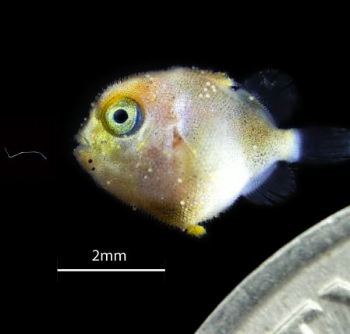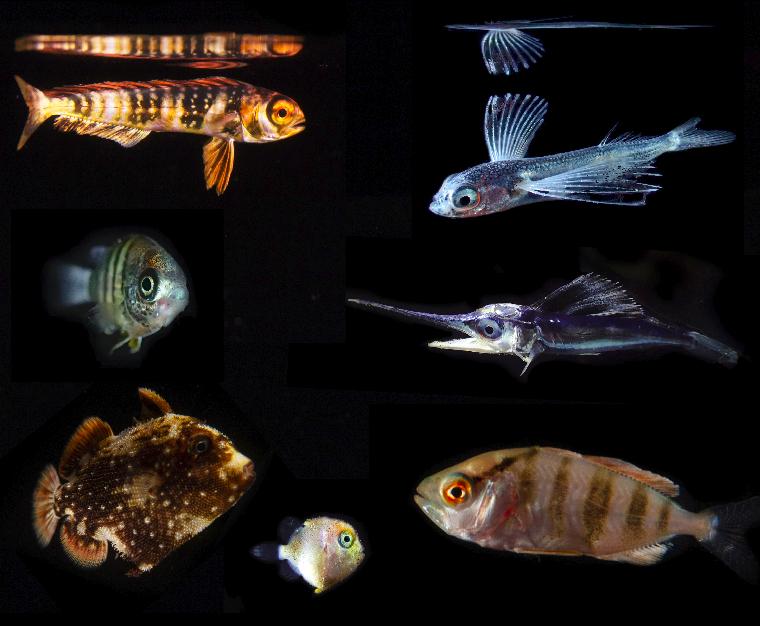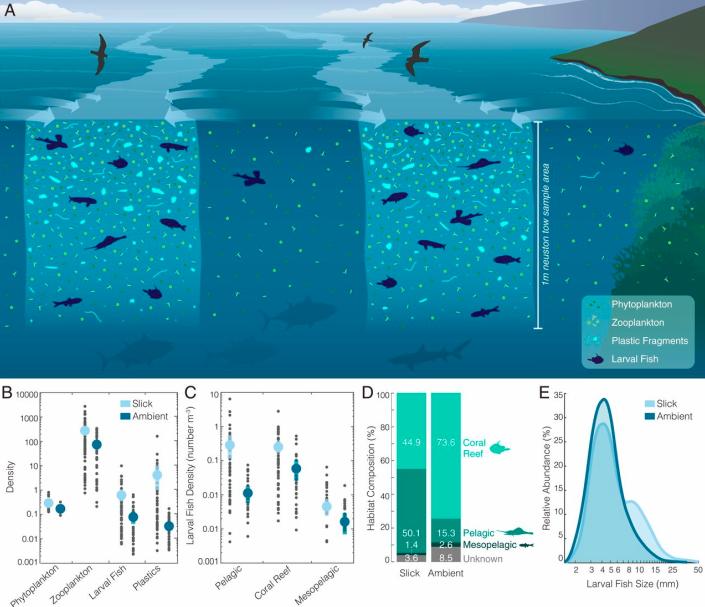|

Larval triggerfish with a ~1mm long blue plastic fiber found in its stomach. Dime shown for scale. Credit: Jonathan Whitney, NOAA Fisheries
Prey-size plastics outnumber larval fish in nursery waters in the Pacific
 UNITED KINGDOM
UNITED KINGDOM
Thursday, November 14, 2019, 06:00 (GMT + 9)
New research has shown for the first time, that larval fish across a range of fish species from different ocean habitats are surrounded by and ingesting plastics in their preferred nursery habitat.
Many of the world’s marine fish spend their first days or weeks feeding and developing at the ocean surface, but little is known about the ocean processes that affect the survival of larval fish. Larval fish are the next generation of adult fish that will supply protein and essential nutrients to people across the world. NOAA’s Pacific Islands Fisheries Science Center and an international team of scientists, including Bangor University in the UK, conducted one of the most ambitious studies to date, to shed light on this critically important knowledge gap.

Surface slicks are naturally occurring ocean surface features that are nursery habitat for larval fish. Slicks concentrate larval fish food and small plastics. Credit: NOAA Fisheries, Jonathan Whitney
Published today in the journal Proceedings of the National Academy of Sciences, the study combined field-based plankton tow surveys and advanced remote sensing techniques to identify larval fish nursery habitat in the coastal waters of Hawai‘i.
 The team found that surface slicks contained far more larval fish than neighbouring surface waters. Surface slicks are naturally occurring, ribbon-like, smooth water features at the ocean surface. “They are formed by convergent ocean processes and observed in coastal marine ecosystems worldwide. They also aggregate plankton, which is an important food resource for larval fish”, said Dr. Jamison Gove, a research oceanographer for NOAA and co-lead of the study. The team found that surface slicks contained far more larval fish than neighbouring surface waters. Surface slicks are naturally occurring, ribbon-like, smooth water features at the ocean surface. “They are formed by convergent ocean processes and observed in coastal marine ecosystems worldwide. They also aggregate plankton, which is an important food resource for larval fish”, said Dr. Jamison Gove, a research oceanographer for NOAA and co-lead of the study.
“We found that surface slicks contained larval fish from a wide range of ocean habitats, from shallow-water coral reefs to the .jpg) open ocean and down into the deep sea—at no other point during their lives do these fish share an ocean habitat in this way,” said Dr. Jonathan Whitney, a marine ecologist for NOAA and co-lead of the study. “Slick nurseries also concentrate lots of planktonic prey, and thereby provide an oasis of food that is critical for larval fish development and survival,” said Dr. Whitney. open ocean and down into the deep sea—at no other point during their lives do these fish share an ocean habitat in this way,” said Dr. Jonathan Whitney, a marine ecologist for NOAA and co-lead of the study. “Slick nurseries also concentrate lots of planktonic prey, and thereby provide an oasis of food that is critical for larval fish development and survival,” said Dr. Whitney.
Larval fish in the surface slicks were larger, well-developed, and had increased swimming abilities. Larval fish that actively swim will better respond and orient to their environment, suggesting that tropical larval fish are actively seeking surface slicks to capitalise on concentrated prey.
 fis_com(1).jpg) “These findings are important because they highlight how complex gradients in plankton and larval fish abundance can occur across what is often assumed to be a featureless ocean surface habitat,” said Dr. Gareth Williams, Associate Professor in Marine Biology at Bangor University’s School of Ocean Sciences (UK) and a senior author of the study. “These findings are important because they highlight how complex gradients in plankton and larval fish abundance can occur across what is often assumed to be a featureless ocean surface habitat,” said Dr. Gareth Williams, Associate Professor in Marine Biology at Bangor University’s School of Ocean Sciences (UK) and a senior author of the study.
The researchers measured the size and distribution of the surface slicks using satellites. Even when viewed from space, surface slicks are distinct from the rest of the ocean. They used more than 100 shoebox-sized satellites built and operated by Planet Incorporated. “Surface slicks had never been mapped before, but we knew it would be vital to scaling up the field-based study. Our new method developed for this study can be applied anywhere in the world,” noted co-author Dr. Greg Asner of Arizona State University’s Center for Global Discovery and Conservation Science.

Numerous larval fish species, often just weeks old, were found to have plastics in their stomachs, including mahi-mahi (top left), flying fish (top right), spearfish (middle right), jacks, (bottom right), triggerfish (two sizes, bottom left), and damsels (middle left). Credit: Jonathan Whitney, NOAA Fisheries
Unfortunately, the team also discovered that the same ocean processes that aggregate prey for larval fish also concentrated buoyant, passively floating plastics. “We were shocked to find that so many of our samples were dominated by plastics,” said Dr. Whitney.
Plastic densities in these surface slicks off Hawai‘i were, on average, 8 times higher than the plastic densities recently found in the Great Pacific Garbage Patch. After 100 net tows, they found that plastics were 126 times more concentrated in surface slicks than in surface water just a couple hundred yards away. Inside the slicks there were seven times more plastics than there were larval fish.

Accumulation densities, natal habitat composition of larval fish, and larval fish size in surface slicks compared to ambient waters. (A) Schematic of study system with indicative slick:ambient ratios for phytoplankton, plastics, zooplankton (i.e., larval fish prey), and larval fish. Note illustrations are not to scale. (B) Median (upper CI, lower CI) density of phytoplankton (i.e., chlorophyll-a, mg m−3), zooplankton (individuals m−3), larval fish (individuals m−3), and plastics (pieces m−3). (C) Median density (upper CI, lower CI) of larval fish by natal habitat. (D) Larval fish natal habitat composition, and (E) relative abundance (%) of larval fish size (n = 10,870 slick, n = 1,032 ambient). (Click to enlarge)
The majority of the plastics found in surface slicks were very small (less than 1 mm). Larval fish prefer their prey this size. After dissecting hundreds of larval fish, the researchers discovered that many fish species ingested plastic particles. “We found tiny plastic pieces in the stomachs of commercially targeted pelagic species, including swordfish and mahi-mahi, as well as in coral reef species like triggerfish,” said Dr. Whitney. Plastics were also found in flying fish, which apex predators such as tunas and most Hawaiian seabirds eat.
“Larval fish are foundational for ecosystem function and represent the future cohorts of adult fish populations. It is alarming that larval fish are surrounded by and ingesting non-nutritious toxin-laden plastics at their most vulnerable life-history stage when nutrition is vital for survival,” said Dr. Gove.
Researchers are not certain whether plastic ingestion is harmful to larval fish. In adult fish, plastics can cause gut blockage, malnutrition, and toxicant accumulation. Larval fish are highly sensitive to changes in their environment and food. Prey-size plastics could impact development and even reduce survivorship of larval fish that ingest them.
.jpg)
Associations between larval fish and plastic, including prey size, in surface slicks compared to ambient waters and examples of larval fish plastic ingestion. (A) Linear fit (solid line) and 95% confidence intervals (CI, shaded region) of plastic (pieces m−3) and larval fish (individuals m−3) densities (dots) in surface slicks (n = 63) and ambient waters (n = 37). (B) Ratio of the median density of plastic to larval fish shown in Fig. 2B. (C) Relative abundance (%) of plastics by size in surface slicks (n = 107,656) and ambient waters (n = 480). (D) Median (upper CI, lower CI) densities of prey-size (≤1 mm) zooplankton (i.e., prey) and prey-size plastics (n = 60 slick, n = 33 ambient). Neuston plankton tow densities (grey dots) are overlaid with bootstrapped median densities (95% CI) as follows: surface slicks (light blue): prey-size zooplankton, 95.62 [129.51, 65.72] and prey-size plastic, 1.75 [4.49, 0.33]; ambient waters (dark blue): prey-size zooplankton, 39.52 [58.98, 23.66] and prey-size plastic, 0.012 [0.021, 0.006]. (E) Ratio of the median density of prey-size plastic to zooplankton prey shown in D. (F) Polymer composition of plastics sampled in surface slicks (n = 707 pieces) as follows: LDPE, low-density polyethylene; unknown PE, unknown polyethylene; HDPE, high-density polyethylene; PP, polypropylene; PP/PE, polypropylene/polyethylene mixture. (G–I) Flying fish (Exocoetidae; G), trigger fish (Balistidae; H), and a billfish (Istiophoridae; I) collected in surface slicks with example pieces of ingested plastics. (Click to enlarge)
“Biodiversity and fisheries production are currently threatened by a variety of human-induced stressors such as climate change, habitat loss, and overfishing. Unfortunately, our research suggests we can likely now add plastic ingestion by larval fish to that list of threats,” said Dr. Gove.
Some scientists criticize the attention on plastic pollution. They say that it is distracting society from tackling more severe threats to global fisheries.
Dr. Williams of Bangor University’s School of Ocean Sciences added:
“We agree that curbing carbon emissions and finding more sustainable ways to fish must be a priority, but our findings suggest further investigation is needed to understand the effects of plastic ingestion by larval fish on individuals and populations. We as a society have the ability to make changes that would alleviate the stress on ecosystems imposed by our activities. We can and should start making those changes now, to limit stress to already severely threatened marine life.”
Source: Bangor University
editorial@seafood.media
www.seafood.media
|
|



